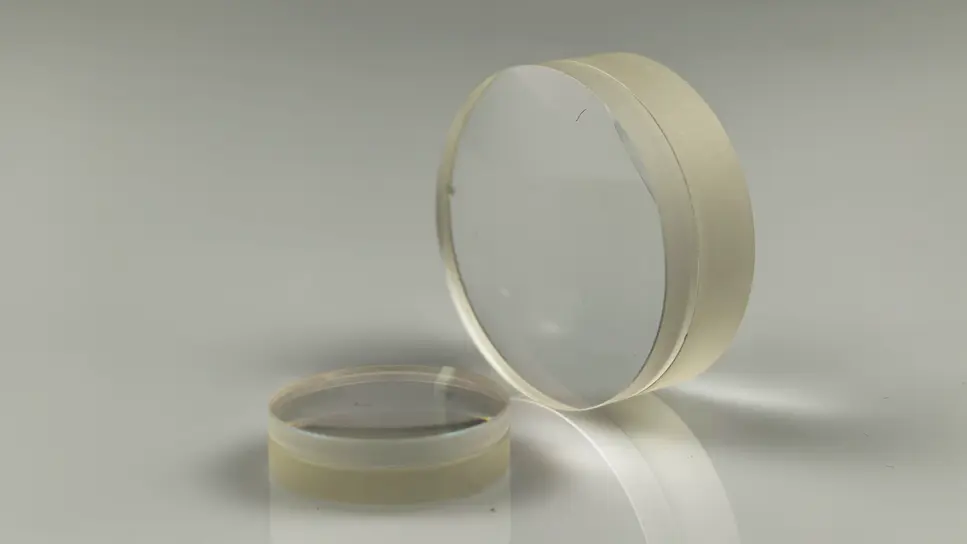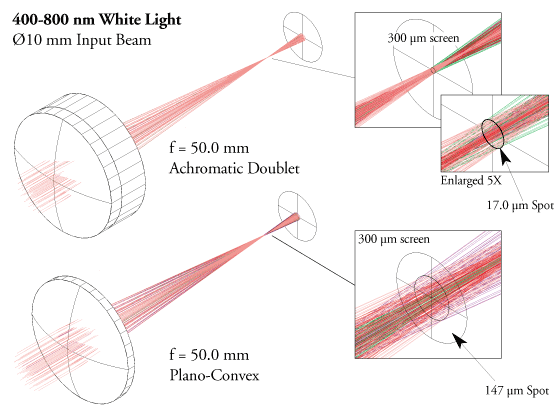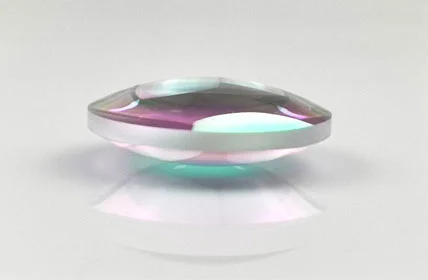en

Achromatic lenses are the ideal solution for correcting chromatic aberration. These multi-element optical components also provide superior correction for monochromatic aberrations.
A standard achromatic lens corrects chromatic aberration for three wavelengths (blue, green, and red light). In such a lens, the convex element converges blue light closer to the focal point, while the concave element disperses blue light more strongly. Since their chromatic aberrations are opposite in sign, red and blue light can be brought to a common focus, effectively eliminating chromatic aberration.
The meniscus surface helps limit spherical aberration and coma, though some astigmatism and distortion may remain. Originally used primarily for landscape photography, these lenses were historically called "landscape lenses." Their characteristic crescent shape (concave-convex) consists of two lenses with different refractive indices and dispersion rates, bonded together.
The earliest achromatic lens was developed by Chevalier in 1821 (a plano-concave and biconvex lens combination), later improved by Grubb in 1857 (using a meniscus design). Modern versions now incorporate multi-layer bonded achromatic lenses for enhanced performance.
| Type | Focal Length | Conjugate Ratio | Chromatic Correction | Applications | Performance Features |
|---|---|---|---|---|---|
| Achromatic Doublet Lens | Positive | Infinite | Good | Broadband focusing & collimating | Improved monochromatic performance |
| Air-Spaced Doublet Lens | Positive | Infinite | Better | Broadband focusing & collimating | Optimized coaxial performance for high-power applications |
| Doublet Lens Pair | Positive | 1X-3.33X | Good | Broadband relay imaging (real objects & images) | Improved monochromatic performance |
| Achromatic Triplet Lens | Positive | 1X-Infinite | Best |
Achromatic Lenses:
Achromatic lenses consist of two or three lens elements and offer significantly better performance than single lenses. These doublet or triplet configurations may feature either cemented elements or air-spaced designs, typically combining positive and negative lenses with different refractive indices.
This multi-element design provides several key advantages:
Reduced chromatic aberration
Improved monochromatic imaging quality
Enhanced off-axis performance
Different types of achromatic lenses offer specific characteristics (such as conjugate ratios and damage thresholds). For applications demanding precise imaging or laser beam manipulation, these achromatic lenses should be strongly considered as they deliver optimized optical performance.

Figure 1: Focusing white light using a plano-convex lens and an achromatic doublet lens
Reducing Chromatic Aberration
Since the refractive index of a material depends on the wavelength of incident light, the focal length of a single lens varies with wavelength. When used with a white light source, this results in blurred focal points—a phenomenon known as chromatic aberration.
Achromatic lenses partially compensate for chromatic aberration through their multi-element design. These lenses typically combine positive and negative lens elements with different dispersion properties. By carefully selecting materials with appropriate dispersion values and focal lengths, chromatic aberration can be partially canceled out.
Achromatic lenses are usually designed to have the same focal length for two wavelengths at opposite ends of the visible spectrum. This ensures a nearly constant focal length across a broad wavelength range, making them advantageous for broadband imaging applications.
Figure 1 illustrates the effect of multiple wavelengths on the focal point when passing through a plano-convex singlet lens versus an achromatic doublet lens. Replacing the singlet with a doublet reduces the focal spot diameter from 147 µm to 17 µm.
Improving Monochromatic Imaging
In monochromatic optical systems, chromatic aberration becomes irrelevant. However, spherical singlets can still introduce significant monochromatic aberrations, such as spherical aberration and coma.
The multi-element design of achromatic lenses reduces these aberrations, significantly improving image quality and focusing performance for monochromatic light.
.png)
Figure 2: Focusing a monochromatic beam using a plano-convex lens and an achromatic doublet lens
Figure 2 compares the focusing performance of a plano-convex singlet and an achromatic doublet under monochromatic illumination. The doublet lens produces a focal spot 4.2 times smaller than the singlet.


